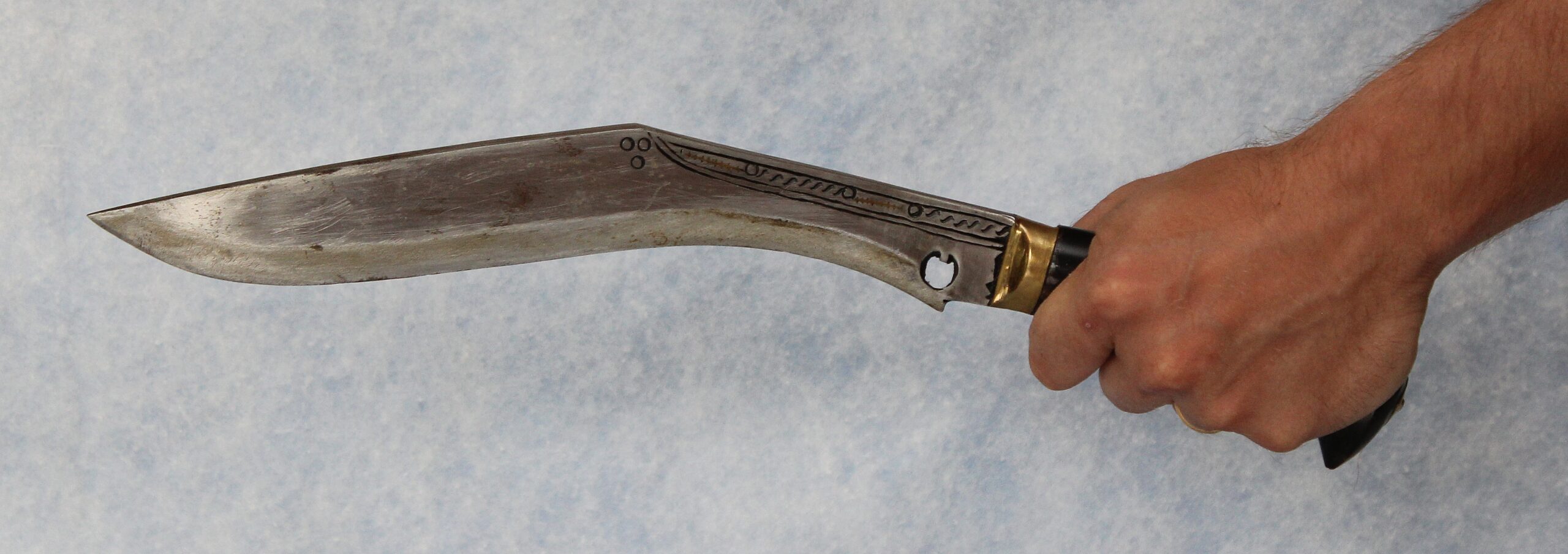Weapon of the Gurkhas
The khukuri (also spelled kukri) is the traditional weapon of the elite Gurkha soldiers. Fierce warriors who hail from the mountainous regions of Nepal have used this ancient blade for centuries. Since 1817, select Nepali warriors have served the crown of Great Britain. When India gained its independence in 1947, several battalions of Gurkhas chose to remain in the subcontinent and have served in the world’s most populous democracy ever since. The reputation of these fighters is so great that the Sultan of Brunei has a contingent in his personal guard, as do the police of Singapore.
Whether serving in Singapore, India, the UK, or working in Iraq or Afghanistan, all Gurkhas carry the khukuri. To call it a knife would be a bit of a misnomer. The khukuri is a blend of knife and hatchet; essentially it is what a bowie knife wants to be when it grows up. While they come with slight variations in shape and thickness, all have a distinctive forward curve to the blade, making them excellent copping weapons. In some ways, the khukuri is similar to the ancient Greek Kopis sword, though there is no evidence that the two weapons are historically linked.
Sirupate
The myth that once a Gurkha has drawn his blade it must draw blood is just that – a myth. The khukuri is an all-purpose tool, used in mundane farm chores, butchery of animals, and as a combat weapon. Some have short, broad blades, perfect for a wide variety of everyday tasks, while another type is designed specifically for slicing through flesh and bone. This latter type is the sirupate.
The sirupate derives its name from its distinctive shape, similar to the leaf of a plant in Eastern Nepal. The siru leaf is long and thin, as is the blade that it inspired. Using methods passed down from father to son, the khukuri-smiths of Taplejung in far-Eastern Nepal have perfected the art of the killing blade. I first encountered this formidable weapon and the men who wield it while in Basrah in 2009. There I worked, lived, and ate with Gurkhas. These men were all former members of the Indian and UK militaries. Danger in a foreign land was no stranger to them, and they kept their traditions alive while living abroad. One such tradition was the way they slaughter animals. In Nepali tradition, the animal should be killed with one blow to the head, resulting in a clean decapitation.
One of my good friends in Basrah was a man we all called Sergeant Major. A former Indian Army commando instructor, he carried an air of quiet invincibility and stood a mere 5’2”. The son and grandson of Gurkhas, he had combat in his blood. I personally witnessed him decapitate a goat with one swing of the khukuri. He did it one-handed.
The last day I was in Basrah, one of my Gurkha friends named Tej presented me with a very special gift; a sirupate khukuri. It has, for a sirupate, a short blade measuring just over 10”. The metal is tough, being made of spring steel, and holds an edge very well. The blade easily cuts through flesh, as several chickens and a groundhog could attest to, were they still alive.
The handle is made from water buffalo horn and the blade has a rat-tail tang that ends in a brass-covered pommel at the rear. The sheath is a simple affair—two pieces of wood wrapped in thin hide, stitched down the back with a small brass cap at the point. Though the design of the sirupate hails from eastern Nepal, I can’t give you a link to the manufacturer’s website. I can direct you to two very fine manufacturers/distributors of khukuri blades.
Khukuri House Thamel Pvt. Ltd.
Like any khukuri, my sirupate weighs much more than a Kabar fighting knife and handles differently as well. Though it can be used in a thrusting attack, the forward-curving nature of the blade lends itself to chopping. The construction of the sirupate is entirely devoted to combat. The balance, heft and very soul of the blade demands to be used. Upon first handling the sirupate an AFSOC friend of mine remarked with some surprise, “I don’t know why, but when I hold this, I just feel like hacking something to pieces.”
“Only Five”
All of this is impressive, but many claim that a personal bladed weapon has little use in modern combat. The United States Army no longer even trains its infantrymen to use the bayonet. Suppressors quiet the sound of the gunshot and modern room-clearing methods are rapid and brutally effective.
Still, I think back to Sergeant Major, a veteran of numerous counter-insurgency campaigns. Whether it was the Muslim terrorists in Jammu-Kashmir or the Tamil Tigers in Sri Lanka, he was often at the front engaging the enemy. At times, when the use of firearms would give his unit away, he resorted to using the khukuri he’d carried for years.
Over a shared supper of rice and curry, Tej once asked Sergeant Major to tell me how many enemy combatants he’d killed. The short, smiling, soft-spoken man looked at me and said in a slightly embarrassed voice, “Only five with the khukuri, sir.”
Only five; he doesn’t even count the ones he’s shot.
By Allen Cosby
Latest posts by 53gr (see all)
- H&H Medical: H Bandage and Thin H Bandage – January 2, 2020
- S&W M&P M2.0 Series – January 9, 2017
- SIG Sauer P938 – October 19, 2016


Leave a Reply